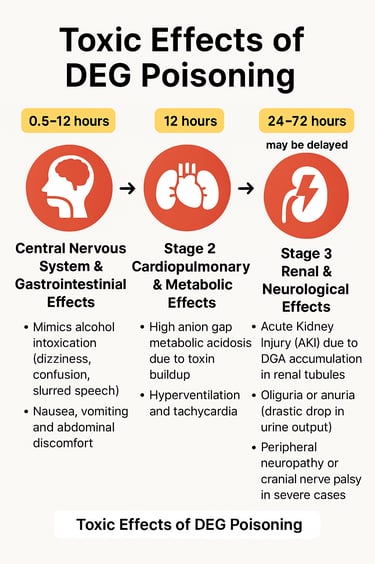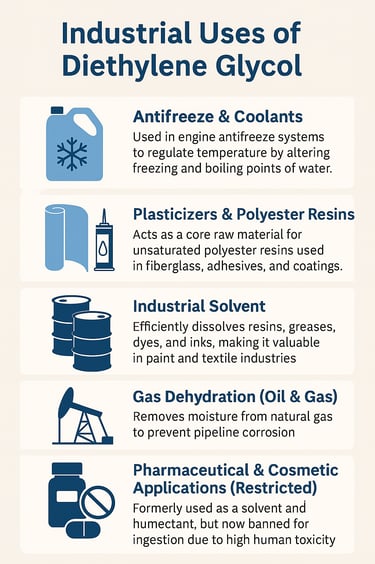A Tragic Cough Syrup Incident That Shook India’s Healthcare Sector
10/21/20253 min read


In one of the most heartbreaking incidents in recent times, at least 22 children lost their lives across Madhya Pradesh and Rajasthan due to acute kidney failure after consuming a cough syrup named Coldrif.
Laboratory investigations confirmed that the syrup contained 48.6% Diethylene Glycol (DEG) — a highly toxic industrial chemical that should never be present in medicines.
🧪 What Is Diethylene Glycol (DEG)?
Chemical Formula: C₄H₁₀O₃
Nature: Colorless, odorless, and hygroscopic liquid
Source: A by-product of ethylene glycol
Diethylene Glycol (DEG) mixes completely with water and organic solvents, making it a valuable industrial solvent — but extremely toxic to humans if ingested. Even small amounts can be fatal.
Antifreeze and Coolants – DEG lowers the freezing point and raises the boiling point of water, making it useful in engine coolants and antifreeze systems.
Plasticizers and Polyester Resins – A key raw material in unsaturated polyester resins used in fiberglass, coatings, and adhesives.
Industrial Solvent – Dissolves resins, dyes, greases, and inks, widely used in paint, coating, and textile industries.
Gas Dehydration – In the oil and gas industry, DEG removes moisture from natural gas.
Pharmaceutical & Cosmetic Applications (Restricted) – Though previously used as a solvent or humectant, DEG is now strictly prohibited for ingestion or medicinal use due to its high toxicity.
⚙️ Industrial Uses of Diethylene Glycol
☠️ Why Is Diethylene Glycol So Dangerous?
Even a small amount of DEG ingestion can be fatal. Its toxicity comes from how it is metabolized in the human body.
⚗️ How DEG Is Metabolized in the Human Body
Once ingested:
Absorption & Conversion – DEG is absorbed in the liver and converted by alcohol dehydrogenase to 2-hydroxyethoxyacetaldehyde.
Toxic Metabolite Formation – This intermediate is further oxidized by aldehyde dehydrogenase into two main toxic metabolites:
2-hydroxyethoxyacetic acid (HEAA)
Diglycolic acid (DGA)
Excretion – Both unmetabolized DEG and HEAA are excreted through the kidneys, leading to their accumulation and subsequent renal damage.
⚕️ Toxic Effects of DEG Poisoning
The accumulation of HEAA and DGA in the body causes progressive organ failure in three stages:
Stage 1: Central Nervous System & Gastrointestinal Effects (0.5–12 hours)
Mimics alcohol intoxication (dizziness, confusion, slurred speech)
Nausea, vomiting, and abdominal discomfort
Stage 2: Cardiopulmonary & Metabolic Effects (~12 hours)
High anion gap metabolic acidosis due to toxin buildup
Hyperventilation and tachycardia
Stage 3: Renal & Neurological Effects (24–72 hours, may be delayed)
Acute Kidney Injury (AKI) due to DGA accumulation in renal tubules
Oliguria or anuria (drastic drop in urine output)
Peripheral neuropathy or cranial nerve palsy in severe cases
💀 How Diglycolic Acid Causes Death
⚡ 1. Direct Renal Injury
DGA selectively damages the proximal tubules in kidneys.
Causes cell necrosis, tubular blockage, and acute renal shutdown.
⚡ 2. Metabolic Collapse
Failure of toxin elimination leads to accumulation of urea, creatinine, and acids.
Results in metabolic acidosis, hyperkalemia, and fluid overload.
⚡ 3. Multi-Organ Failure
Toxin buildup affects heart rhythm, neurological function, and respiratory control.
Leads to arrhythmias, seizures, coma, and cardiac arrest if untreated.
Without urgent dialysis or critical care, death usually occurs within 48–72 hours.




🛡️ Preventive Measures After the Coldrif Incident
Following the tragedy, the Union Health Ministry and CDSCO (Central Drugs Standard Control Organization) initiated comprehensive safety reforms:
🚫 Immediate recall and ban of Coldrif and similar formulations.
🔒 Sealing of manufacturing units and initiation of criminal proceedings.
⚖️ Strict enforcement of Schedule M (Good Manufacturing Practices).
🧪 Mandatory DEG and EG testing in all raw materials and finished liquid products.
🏭 Manufacturing plant upgrades to meet international GMP standards by December 2025.
🔍 Enhanced pharmacovigilance and market surveillance to detect early risks.
👶 Restrictions on pediatric cough and cold syrups.
📢 Public awareness campaigns about DEG poisoning and safe alternatives for children.
